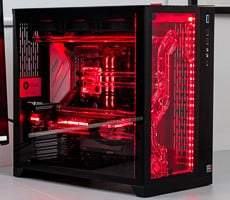AMD DTX Small Form Factor System Sneak Peek
AMD cites a market need for a smaller, quieter, desktop-friendly PCs as the reason behind the DTX open standard. AMD's design target for DTX systems are processors with 45w to 65w TDPs. As such the prototype system we received for evaluation was powered by a low-power AMD Athlon X2 BE-2350 processor that was installed in an AMD DTX motherboard based on the 690G series chipset. All of the parts were housed in a slim chassis that could be stood horizontally or vertically. Standing upright, the dimensions of the chassis are roughly 14” high, 13” deep and about 4” wide, which is a fraction of the size of a standard mid-tower. There are ventilation holes around the rim of the chassis, on both the top and bottom, to help with cooling the system’s internal components. And on the top removable panel, there are additional ventilation holes cut out for the CPU cooler on the prototype. We’re told, however, that the next revision will also feature better ventilation for the power supply. The front of the system is equipped with a simple, lighted power switch and a removable cover that hides a slim optical drive, USB and audio ports, a memory card reader, as well as an empty slot. The prototype made use of a crude plastic cover, but future designs are likely to have hinged covers. At the rear of the system a typical array of connectors are visible. The power supply is vented and uses a typical 3-pin power cord. The prototype DTX motherboard had an RJ45 jack, VGA and DVI connectors, four USB ports, analog and digital audio connectors in its I/O backplane and the chassis can accommodate two half-height expansion cards. The array of I/O connectors visible here is somewhat lacking in comparison to many current Micro-ATX boards, but as you’ll see on the next page there is plenty of room within the chassis to accommodate more. Please keep in mind that the model we tested was an early prototype.







